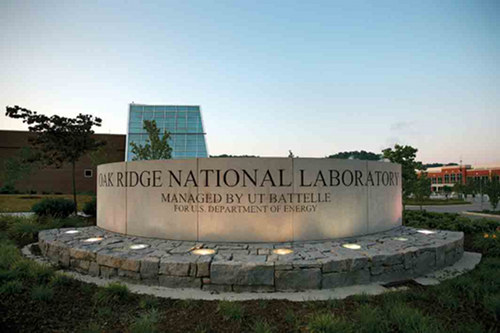A House bill approved Wednesday rejected the Trump administration’s proposed funding cut of about $900 million for the U.S. Department of Energy Office of Science.
Instead of cutting, the House Appropriations Committee bill would keep spending flat for the Office of Science, holding it at $5.39 billion in the next fiscal year, the same as in the current fiscal year.
That could be good news for DOE Office of Science laboratories and offices here, including Oak Ridge National Laboratory and the Office of Scientific and Technical Information, or OSTI.
Separately, the House bill recommends a funding increase for the National Nuclear Security Administration. That’s something that the Trump administration had also proposed. The NNSA is a semi-autonomous agency within DOE, and its activities include nuclear weapons work, nuclear nonproliferation efforts, and naval reactors. The Y-12 National Security Complex in Oak Ridge is an NNSA site.
“Issues of national and economic security are continually on the forefront of the minds of all Americans,” said U.S. Representative Chuck Fleischmann, a Republican whose district includes Oak Ridge. “Last week, the House Appropriations Committee, on which I serve, approved the Fiscal Year 2018 Energy and Water Appropriations Bill. I was proud to help direct additional funding towards the national security programs at Y-12.
“Additionally, funding levels included in this legislation will allow for cleanup of high risk excess facilities at Y-12. This is the first step in a long process, and I want to assure my constituents that I will continue fighting to ensure that Y-12, Oak Ridge National Laboratory, and environmental management activities get the funding needed to continue their critical missions.”
Besides being a member of the House Appropriations Committee, Fleischmann is vice chair of the Appropriations Committee’s Energy and Water Subcommittee.
There are still cuts proposed in the House bill, including to DOE’s Energy Efficiency and Renewable Energy. It’s not yet clear how those reductions, if approved, might affect Oak Ridge sites such as ORNL. Under the House bill, Energy Efficiency and Renewable Energy, or EERE, would be cut by about 50 percent, from roughly $2 billion to $1.1 billion. EERE provided $116.9 million to ORNL in fiscal year 2015, and it is a partner at an ORNL showcase facility, the Manufacturing Demonstration Facility in Hardin Valley.
Still, the energy and water development appropriations bill approved by the House Appropriations Committee on Wednesday appears to generally make smaller cuts than requested by the Trump administration, including to EERE, or not make a cut at all in the case of the Office of Science.
Under the House bill, overall funding for the U.S. Department of Energy would be cut by about $858 million, or 2.8 percent. Total DOE spending would drop from about $30.75 billion in fiscal year 2017 to $29.89 billion in fiscal year 2018, which starts October 1.
That cut would be roughly $2 billion less than the one requested by the Trump administration. In his budget request submitted to Congress in May, President Donald Trump had asked to cut DOE spending by close to $3 billion, or roughly 10 percent, dropping it to $27.87 billion.
Under the House bill, funding for the National Nuclear Security Administration would increase to $13.9 billion. That funding would be up roughly $976 million compared to the current fiscal year. The increase recommended for the NNSA by the House is about $16 million less than proposed by the Trump administration.
The House bill would cut overall funding for DOE energy programs, including basic science research and applied energy programs, and it would not provide any funds for the Advanced Research Projects Agency—Energy, or ARPA-E. U.S. Senator Lamar Alexander, a Tennessee Republican who, like Fleischmann, often advocates for the federal sites in Oak Ridge, has opposed cutting ARPA-E.
The House bill would also cut environmental management, or EM, activities for non-defense environmental cleanup, uranium enrichment decontamination and decommissioning, and defense environmental cleanup. It’s not immediately clear how that would affect Oak Ridge, where there is an EM program.
In a Wednesday press release, the House Appropriations Committee said its bill, which was approved on a voice vote, would target funding toward national security work, including nuclear weapons activities, and investments in energy and water infrastructure.
“National security is our number one priority, and this bill will fund essential programs that maintain our nuclear deterrence posture in the face of growing global threats, including North Korea and other countries that are testing the tolerance of the international community,â€Â House Appropriations Committee Chairman Rodney Frelinghuysen said in the press release. “Further, this legislation will make important investments in our energy development and water infrastructure to keep our economy growing and to continue the country’s lead in essential energy technology and innovation.â€
Here are some recommendations of the House bill, according to a House Appropriations Committee report:
DOE—$29.89 billion. Overall funding would be down from fiscal year 2017, but still higher than the president’s request for fiscal year 2018.
- Energy Efficiency and Renewable Energy—$1.1 billion. This funding would be down about 50 percent from $2 billion in 2017, but it’s a smaller cut than the one proposed by the Trump administration.
- Non-defense environmental cleanup—$222 million, a cut of about $24.6 million. In the bill, the committee told DOE that it shall give Congress an update on the memorandum of agreement for the historic preservation of the K-25 gaseous diffusion uranium enrichment building in Oak Ridge within 30 days after the bill is enacted.
- Uranium Enrichment Decontamination and Decommissioning Fund—$768 million, the same as in fiscal year 2017. This fund was established by the Energy Policy Act of 1992 to pay for the cleanup of gaseous diffusion plants in Portsmouth, Ohio; Paducah, Kentucky; and at the East Tennessee Technology Park (the former K-25 site) in Oak Ridge.
- Science—$5.39 billion, the same as in fiscal year 2017. The Office of Science is the nation’s largest supporter of basic research in the physical sciences. Alexander has previously said that the $5.39 billion for the Office of Science in 2017 was a record funding level in a regular appropriations bill.
- Advanced scientific computing research—$112 million for the Oak Ridge Leadership Computing Facility at ORNL. This is part of some funding that is outlined for high performance computing and network facilities.
- NNSA—$10.24 billion, an increase of about $921 million from fiscal year 2017. The NNSA is a semi-autonomous part of DOE.
- Excess facility disposition at Y-12, Pantex Plant, and other NNSA sites—$43 million, including up to $9 million to demolish facilities and utilities along a proposed new leg of the perimeter intrusion detection system (PIDAS) at Y-12, and up to $7 million to support “de-inventory, risk reduction, and pre-demolition activities†at Alpha 5 and Beta-4. That work must be done before the NNSA can transfer the buildings to DOE’s Office of Environmental Management, or EM, the report said.
- Uranium Processing Facility at Y-12—$620 million, which is described as full funding of the needs for fiscal year 2018. But as part of an effort to address a growth in project costs, the funding request would be deferred until a full independent cost estimate has been provided to appropriations committees in the House and Senate, the report said.
- West End Protected Area Reduction Project at Y-12—$23.4 million. The NNSA is directed to provide quarterly updates on this project to appropriations committees in the House and Senate.
- Defense nuclear nonproliferation—$1.83 billion, down about $76 million from 2017.
- Defense environmental cleanup—$5.4 billion, the same as in 2017. This funding includes funding above the president’s budget request for individual EM sites to accelerate known demolition projects and start new transfers to EM. Those include $35 million for nuclear facility cleanup in Oak Ridge to support the demolition of the Y-12 Biology Complex. The House recommendation also includes $52.3 million for plans to dispose of U233 at the Oak Ridge Reservation, $17.1 million for construction of the Mercury Treatment Facility at Y-12, and $10 million for construction of an on-site waste disposal facility.
- Other projects at Y-12—$28 million for a fire station and $7 million for an emergency operations center.

U.S. Senator Lamar Alexander, center, a Tennessee Republican, is pictured above with Energy Secretary Rick Perry, left, at Oak Ridge National Laboratory’s Manufacturing Demonstration Facility on Hardin Valley Road on Monday, May 22, 2017. Also pictured is former ORNL Director Thom Mason. (Photo by John Huotari/Oak Ridge Today)
Here’s what Energy and Water Subcommittee Chairman Mike Simpson said about the bill approved Wednesday: “This bill prioritizes fulfilling our national security needs and maintaining critical investments to support American competitiveness within tight budget caps. It strikes a responsible balance between the modernization and safety of our nuclear weapons, advancing our national infrastructure, and strategic investments in basic science and energy R&D (research and development).â€
The next fiscal year starts October 1. It’s not clear what might eventually pass Congress. A few officials have said that one option is a continuing resolution, keeping spending at current levels.
In the Senate, the Energy and Water Development Appropriations Subcommittee will mark up the Energy and Water Development and Related Agencies Appropriations Act of 2018 this afternoon (Tuesday, July 18). The full Senate Appropriations Committee markup is scheduled for Thursday morning, July 20. A markup is the process that congressional committees and subcommittees use to debate, amend, and rewrite proposed legislation.
Alexander is chair of the Senate’s Energy and Water Development Appropriations Subcommittee.
See our previous DOE budget stories from this year here:
- President’s budget: DOE cleanup funding could be up, with benefits for Oak Ridge
- NNSA: Y-12 funding would be up 25 percent under president’s budget request
- Feinstein: President’s budget request could lead to 1,600 layoffs at ORNL
- Funding for ORNL could be cut $185 million under president’s budget
- President’s budget request includes money for two UPF buildings at Y-12
See the House Appropriations Committee press release from Wednesday here.
See the House Appropriations Committee report on the Energy and Water Development Appropriations for fiscal year 2018Â here.
See the House Appropriations energy and water bill here.
More information will be added as it becomes available.
Do you appreciate this story or our work in general? If so, please consider a monthly subscription to Oak Ridge Today. See our Subscribe page here. Thank you for reading Oak Ridge Today.
Copyright 2017 Oak Ridge Today. All rights reserved. This material may not be published, broadcast, rewritten, or redistributed.










Leave a Reply